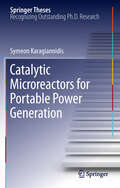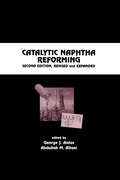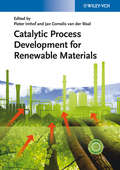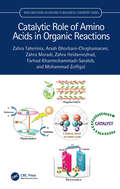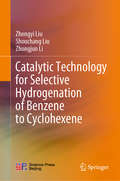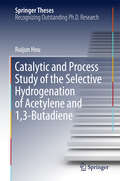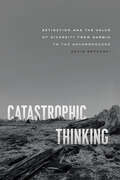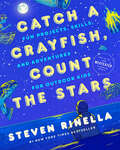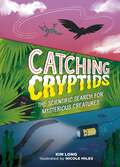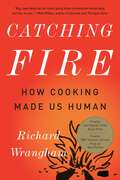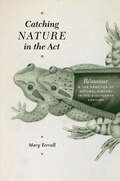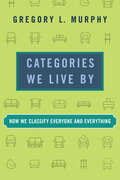- Table View
- List View
Catalytic Microreactors for Portable Power Generation (Springer Theses)
by Symeon Karagiannidis"Catalytic Microreactors for Portable Power Generation" addresses a problem of high relevance and increased complexity in energy technology. This thesis outlines an investigation into catalytic and gas-phase combustion characteristics in channel-flow, platinum-coated microreactors. The emphasis of the study is on microreactor/microturbine concepts for portable power generation and the fuels of interest are methane and propane. The author carefully describes numerical and experimental techniques, providing a new insight into the complex interactions between chemical kinetics and molecular transport processes, as well as giving the first detailed report of hetero-/homogeneous chemical reaction mechanisms for catalytic propane combustion. The outcome of this work will be widely applied to the industrial design of micro- and mesoscale combustors.
Catalytic Naphtha Reforming Process
by Soni O OyekanBased on the author’s decades of years of experience in oil refining, Catalytic Naphtha Reforming Process conveys essential information on key concepts, operations, and practices of catalytic naphtha reforming technologies and associated oil refining processes. The book reviews collective technical and operational advancements with respect to efficient use of catalysts and catalytic reformers in oil refining and incorporates key advancements from recent developments in catalytic reforming technologies and processes. High octane reformate gasoline blendstock production via the use of high performing continuous catalyst regenerative processes is emphasized for regulated, environmentally friendly gasoline. The benefits of timely, effective process unit monitoring are covered in this book. Some of the principal objectives of this book include the need to emphasize more proactive approaches in the planning, operations and maintenance of catalytic reforming units and oil refineries. A number of recommendations are provided for enhancing the operations, reliability, and productivity of catalytic reformers and oil refineries.
Catalytic Naphtha Reforming, Revised and Expanded (Chemical Industries)
by George J. Antos Abdullah M. AitaniCatalytic Naphtha Reforming, Second Edition presents modern, crystal-clear explanations of every aspect of this critical process for generating high-octane reformate products for gasoline blending and production of benzene, toluene, and xylene (BTX) aromatics. The book details the chemistry of naphtha reforming, the preparation and characterization
Catalytic Process Development for Renewable Materials
by Pieter Imhof Jan Cornelis van der WaalGreen, clean and renewable are the hottest keywords for catalysis and industry. This handbook and ready reference is the first to combine the fields of advanced experimentation and catalytic process development for biobased materials in industry. It describes the entire workflow from idea, approach, research, and process development, right up to commercialization. A large part of the book is devoted to the use of advanced technologies and methodologies like high throughput experimentation, as well as reactor and process design models, with a wide selection of real-life examples included at each stage. The contributions are from authors at leading companies and institutes, providing firsthandinformation and knowledge that is hard to find elsewhere.This work is aimed at decision makers, engineers and chemists in industry, chemists and engineers working with/on renewables, chemists in the field of catalysis, and chemical engineers.
Catalytic Role of Amino Acids in Organic Reactions (New Directions in Organic & Biological Chemistry)
by Zahra Taherinia Arash Ghorbani-Choghamarani Zahra Moradi Zahra Heidarnezhad Farhad Khanmohammadi-Sarabib Mohammad ZolfigolAsymmetric organometallic and organocatalytic processes have attracted great interest. Asymmetric synthesis using both natural and unnatural amino acids has been tremendously important from synthetic as well as industrial viewpoints, and numerous new methodologies have been developed in the last decades. Herein we provide an overview of old and very recent (since 1900 till now) advances and applications in the area of heterogeneous catalysis, homogeneous catalysis, electrocatalysis, photocatalysis, organocatalysis, thermal catalysis using amino acids [proline, glycine, alanine, valine, serine, threonine, cysteine, methionine, asparagine, glutamine, lysine, arginine, histidine, aspartate, glutamate, phenylalanine, and tryptophan], (supported or unsupported), an amino acid containing materials or amino acids derivatives as an essential component of catalysts, this book highlights the most important and recent developments to immobilize or support amino acids on various support materials. This book is suitable as supplementary reading for courses targeting the design, synthesis, and application of chiral catalysts, asymmetric catalysis, and sustainable production.
Catalytic Technology for Selective Hydrogenation of Benzene to Cyclohexene
by Zhongyi Liu Shouchang Liu Zhongjun LiThis book provides a comprehensive description of the catalytic technologies for selective hydrogenation of benzene to cyclohexene. Focusing on selective hydrogenation of benzene to prepare cyclohexene and its downstream products, such as cyclohexanone, bulk chemicals and high-value fine chemicals, it also discusses the objective laws, reaction mechanisms and scientific significance based on experimental data, analysis and characterization results. Given its scope, the book will appeal to a broad readership, particularly professionals at universities and scientific research institutes, senior undergraduates, master's and doctoral graduate students as well as practitioners in industry.
Catalytic Transformations of Sustainable and Versatile Furanic Chemicals
byDiminishing confined fossil resources has spurred the scientific community to strive for alternative, sustainable resources, such as terrestrial biomass, which can potentially substitute fossil-based derivatives. Lignocellulosic biomass is deemed an indispensable carbon source for meeting industrial and social demands regarding energy/fuels and chemicals. Over the past decade, significant advances have been shown in developing a broad spectrum of high-value chemicals and functional materials derived from biomass-based substrates. In connection with this, furanic chemicals, such as 5-hydroxymethylfurfural (HMF) and furfural, have recently received considerable attention due to their potential applications. Catalytic Transformations of Sustainable and Versatile Furanic Chemicals aims to explicitly display the latest technical developments on designing functional catalysts, optimizing process and reaction parameters, and improving the stability of the employed materials on the transformation of HMF and furfural to a wide range of value-added chemicals via oxidation, reduction, hydrodeoxygenation, and reductive amination processes.Features: Highlighting the importance and significance of HMF and furfural. Evaluating the transformations of HMF and furfural with various catalytic processes. Designing robust and efficient catalytic systems. Understanding the stability of catalytic materials. Understanding the characteristic features of the catalytic materials. This book aims to target not only researchers focusing on biomass valorization from academic to industrial sectors but also graduate students interested in pursuing their higher education in biochemicals (especially furanic compounds), covering various aspects in organic synthesis routes, preparation of inorganic materials and physico-chemical properties, for both chemists and chemical engineers.
Catalytic and Process Study of the Selective Hydrogenation of Acetylene and 1,3-Butadiene (Springer Theses)
by Ruijun HouThis thesis offers novel methods for catalyst and process design for the selective hydrogenation of acetylene and 1,3-butadiene. The author predicts the properties of supported Pd-Ni bimetallic catalysts using density functional theory (DFT) calculations and temperature-programmed desorption (TPD). The excellent correlation between model surfaces and supported catalysts demonstrates the feasibility of designing effective bimetallic catalysts for selective hydrogenation reactions. The author also proposes a method for designing non-precious metal catalysts to replace precious metals. He modifies the process of selective hydrogenation of acetylene by coupling the selective adsorption to the selective hydrogenation in the liquid phase, as a result of which the ethylene selectivity is greatly improved and heat transfer is greatly enhanced. Lastly, by analyzing the mechanism of liquid-phase hydrogenation, the author proposes a multi-stage slurry bed reactor for industrial applications.
Catalytically Active Nucleic Acids (Advances in Biochemical Engineering/Biotechnology #170)
by Harald Seitz Frank Stahl Johanna-Gabriela WalterThis volume reviews numerous reaction mechanisms and applications of nucleic acids with catalytic activity. Written by an interdisciplinary team of authors, it provides an essential overview of these acids’ fundamental aspects, while also addressing associated methodologies such as nucleic acid enzyme engineering, peroxidase-mimicking DNAzymes and Aptazymes. After the discovery of natural ribozymes – RNA molecules that mediate the cleavage and formation of phosphodiester bonds and the formation of peptide bonds – numerous artificial ribozymes with altered catalytic activities were produced by in vitro and in vivo selection. Unlike ribozymes, DNAzymes do not occur in nature. Although the catalytic activity of nucleic acid enzymes is usually much slower than that of proteins, nucleic acid enzymes with comparable catalytic activity have been obtained using stringent selection processes. The key advantages of these enzymes: they are e.g. smaller, easier to produce and purify than proteins, and can withstand denaturation, e.g. by heat. Over the last few years, the number of publications on the applications of enzymatic nucleic acids has grown steadily. Summarizing the fundamentals and applications of these acids, this book will not only be an excellent resource for experts in the field but will also guide young researchers just starting out in this significant area.
Catalyzed Carbon-Heteroatom Bond Formation
by Andrei K. YudinWritten by an experienced editor widely acclaimed within the scientific community, this book covers everything from oxygen to nitrogen functionalities. From the contents: * Palladium-Catalyzed Syntheses of Five-Membered Saturated Heterocycles * The Formation of Carbon-Sulfur and Carbon-Selenium Bonds by Substitution and Addition Reactions Catalyzed by Transition Metal Complexes * Palladium-Catalysis for Oxidative 1,2-Difunctionalization of Alkenes * Palladium-Catalyzed Formation of Aromatic Heterocycles * Rhodium-Catalyzed Amination of C-H-Bonds * Transition Metal-Catalyzed Synthesis of Heterocycles * Copper-Catalyzed Synthesis of Azoles * Palladium(II)-Catalyzed C-N Bond Formation Involving Aminopalladation of Aklenes * Carbon-Heteroatom Bond Formation by Rh(I)-Catalyzed Ring-Opening Reactions * Recent Advances in Homogeneous Gold Catalysis: Formation of Carbon-Heteroatom Bonds The result is an indispensable source of information for the strategic planning of the synthetic routes for organic, catalytic and medicinal chemists, as well as chemists in industry.
Catalyzing Inquiry at the Interface of Computing and Biology
by National Research Council of the National AcademiesAdvances in computer science and technology and in biology over the last several years have opened up the possibility for computing to help answer fundamental questions in biology and for biology to help with new approaches to computing. Making the most of the research opportunities at the interface of computing and biology requires the active participation of people from both fields. While past attempts have been made in this direction, circumstances today appear to be much more favorable for progress. To help take advantage of these opportunities, this study was requested of the NRC by the National Science Foundation, the Department of Defense, the National Institutes of Health, and the Department of Energy. The report provides the basis for establishing cross-disciplinary collaboration between biology and computing including an analysis of potential impediments and strategies for overcoming them. The report also presents a wealth of examples that should encourage students in the biological sciences to look for ways to enable them to be more effective users of computing in their studies.
Catastrophe Ethics: How to Choose Well in a World of Tough Choices
by Travis RiederHow to live a morally decent life in the midst of today's constant, complex choices In a world of often confusing and terrifying global problems, how should we make choices in our everyday lives? Does anything on the individual level really make a difference? In Catastrophe Ethics, Travis Rieder tackles the moral philosophy puzzles that bedevil us. He explores vital ethical concepts from history and today and offers new ways to think about the &“right&” thing to do when the challenges we face are larger and more complex than ever before. Alongside a lively tour of traditional moral reasoning from thinkers like Plato, Mill, and Kant, Rieder posits new questions and exercises about the unique conundrums we now face, issues that can seem to transcend old-fashioned philosophical ideals. Should you drink water from a plastic bottle or not? Drive an electric car? When you learn about the horrors of factory farming, should you stop eating meat or other animal products? Do small commitments matter, or are we being manipulated into acting certain ways by corporations and media? These kinds of puzzles, Rieder explains, are everywhere now. And the tools most of us unthinkingly rely on to &“do the right thing&” are no longer enough. Principles like &“do no harm&” and &“respect others&” don&’t provide guidance in cases where our individual actions don&’t, by themselves, have any effect on others at all. We need new principles, with new justifications, in order to navigate this new world. In the face of consequential and complex crises, Rieder shares exactly how we can live a morally decent life. It&’s time to build our own catastrophe ethics.
Catastrophic Events Student Guide and Source Book (2nd Edition)
by Carol O’donnellThis edition of student guide and source book on Catastrophic Events contains three parts viz., Storms, Earthquakes and Volcanoes. Also included are Glossary, Index, Photo Credits and Selected References.
Catastrophic Thinking: Extinction and the Value of Diversity from Darwin to the Anthropocene (science.culture)
by David SepkoskiA history of scientific ideas about extinction that explains why we learned to value diversity as a precious resource at the same time as we learned to “think catastrophically” about extinction. We live in an age in which we are repeatedly reminded—by scientists, by the media, by popular culture—of the looming threat of mass extinction. We’re told that human activity is currently producing a sixth mass extinction, perhaps of even greater magnitude than the five previous geological catastrophes that drastically altered life on Earth. Indeed, there is a very real concern that the human species may itself be poised to go the way of the dinosaurs, victims of the most recent mass extinction some 65 million years ago. How we interpret the causes and consequences of extinction and their ensuing moral imperatives is deeply embedded in the cultural values of any given historical moment. And, as David Sepkoski reveals, the history of scientific ideas about extinction over the past two hundred years—as both a past and a current process—is implicated in major changes in the way Western society has approached biological and cultural diversity. It seems self-evident to most of us that diverse ecosystems and societies are intrinsically valuable, but the current fascination with diversity is a relatively recent phenomenon. In fact, the way we value diversity depends crucially on our sense that it is precarious—that it is something actively threatened, and that its loss could have profound consequences. In Catastrophic Thinking, Sepkoski uncovers how and why we learned to value diversity as a precious resource at the same time as we learned to think catastrophically about extinction.
Catch a Crayfish, Count the Stars: Fun Projects, Skills, and Adventures for Outdoor Kids
by Steven RinellaA hands-on, gloves-off, muddy-boots activity book for young adventurers ages eight and up, offering fun projects and adventures to build lifelong skills and knowledge about the natural world—from the host of MeatEater and the New York Times bestselling author of The MeatEater Guide to Wilderness Skills and Survival <p><p> Does climbing a tree, building a bug hotel, spearing a bullfrog, stalking wild animals, and scouting for petrified wood sound more fun than homework or chores? If so, this guide is your perfect companion to endless summer days and rainy fall afternoons alike. Filled with advice, insights, and activities to inspire wonder and excitement about the natural world, Catch a Crayfish, Count the Stars is a curious kid’s treasure trove, filled to the brim with outdoor projects, skills, and adventures complete with illustrations. The book presents a ton of fun and exciting ways to explore the natural world, like <p>• building an outdoor exploration kit <p>• identifying constellations and navigating using the sun and stars <p>• collecting fossils and other geological wonders <p>• tracking animals and following weather patterns <p>• making your own compass <p>• growing your own fruits and vegetables <p>• building survival shelters and primitive hunting weapons <p>• fishing, hunting, and foraging for wild foods <p>• making cool art projects using natural materials <p><p> A must-have guide for budding naturalists, scientists, gardeners, anglers, foragers, and hunters, Catch a Crayfish, Count the Stars helps get kids out into nature, imparting lifelong knowledge and skills along the way. <p> <b>New York Times Bestseller</b>
Catch the Wind, Harness the Sun: 22 Super-Charged Projects for Kids
by Michael J. CadutoGet charged up about energy! With more than 20 fun activities and experiments that will have children ages 8 to 12 enthusiastically engaged with making and using renewable energy, Michael J. Caduto takes a hands-on approach to fighting climate change. Step-by-step instructions for projects range from using the sun to make fires to charging electronic devices by peddling your bicycle. Additional energy case studies encourage kids to think about the basic tenets of resource management. Change the world — one miniature windmill at a time.
Catching Air: Taking the Leap with Gliding Animals (How Nature Works)
by Sneed B. Collard III*NSTA Outstanding Science Trade Book* *Junior Library Guild Selection 2017* Only a few dozen vertebrate animals have evolved true gliding abilities, but they include an astonishing variety of mammals, reptiles, and amphibians. North America’s flying squirrels and Australia’s sugar gliders notwithstanding, the vast majority of them live in rainforests. Illustrated with arresting photographs, Catching Air takes us around the world to meet these animals, learn why so many gliders live in Southeast Asia, and find out why this gravity-defying ability has evolved in Draco lizards, snakes, and frogs as well as mammals. Why do gliders stop short of flying, how did bats make that final leap, and how did Homo sapiens bypass evolution to glide via wingsuits and hang gliders—or is that evolution in another guise?
Catching Cryptids: The Scientific Search for Mysterious Creatures
by Kim LongLearn how to find Kraken, Mothman, Microbats, and more in this fun, fact-filled, STEM-based cryptozoology book for fans of The Book of Mythical Beasts and Magical Creatures. For years the kraken was considered a mythical beast. Then, in 2004, high-tech cameras captured a photo of a living giant squid. Advances in technology have provided scientists with new tools to study previously undiscovered/unresearched habitats: high-tech cameras, forensic analysis, underwater robots, bioacoustics, infrared sensors, drones, remote control photography and measurement tools, airborne DNA, footprint identification, and more. Catching Cryptids explores these technological advances in a fun way by pairing them with mythical creatures and discussing how modern technology could be used to locate or &“catch&” these beasts. The book includes a mini history of each cryptid, along with interesting facts about the corresponding field of science, and spot illustrations throughout. Featuring over 45 creatures found on land, in water, and among the skies, Catching Cryptids will leave readers wondering what&’s next? The phoenix? Dragons? The possibilities are endless! A Junior Library Guild (JLG) Gold Standard Selection!
Catching Fire: How Cooking Made Us Human
by Richard WranghamEver since Darwin and The Descent of Man, the existence of humans has been attributed to our intelligence and adaptability. But in Catching Fire, renowned primatologist Richard Wrangham presents a startling alternative: our evolutionary success is the result of cooking. In a groundbreaking theory of our origins, Wrangham shows that the shift from raw to cooked foods was the key factor in human evolution. When our ancestors adapted to using fire, humanity began. Once our hominid ancestors began cooking their food, the human digestive tract shrank and the brain grew. Time once spent chewing tough raw food could be sued instead to hunt and to tend camp. Cooking became the basis for pair bonding and marriage, created the household, and even led to a sexual division of labor. Tracing the contemporary implications of our ancestors' diets, Catching Fire sheds new light on how we came to be the social, intelligent, and sexual species we are today. A pathbreaking new theory of human evolution, Catching Fire will provoke controversy and fascinate anyone interested in our ancient origins--or in our modern eating habits.
Catching Nature in the Act: Réaumur & the Practice of Natural History in the Eighteenth Century
by Mary TerrallNatural history in the eighteenth century was many things to many people—diversion, obsession, medically or economically useful knowledge, spectacle, evidence for God’s providence and wisdom, or even the foundation of all natural knowledge. Because natural history was pursued by such a variety of people around the globe, with practitioners sharing neither methods nor training, it has been characterized as a science of straightforward description, devoted to amassing observations as the raw material for classification and thus fundamentally distinct from experimental physical science. In Catching Nature in the Act, Mary Terrall revises this picture, revealing how eighteenth-century natural historians incorporated various experimental techniques and strategies into their practice. At the center of Terrall’s study is René-Antoine Ferchault de Réaumur (1683–1757)—the definitive authority on natural history in the middle decades of the eighteenth century—and his many correspondents, assistants, and collaborators. Through a close examination of Réaumur’s publications, papers, and letters, Terrall reconstructs the working relationships among these naturalists and shows how observing, collecting, and experimenting fit into their daily lives. Essential reading for historians of science and early modern Europe, Catching Nature in the Act defines and excavates a dynamic field of francophone natural history that has been inadequately mined and understood to date.
Catching Nature in the Act: Réaumur and the Practice of Natural History in the Eighteenth Century
by Mary TerrallNatural history in the eighteenth century was many things to many people--diversion, obsession, medically or economically useful knowledge, spectacle, evidence for God’s providence and wisdom, or even the foundation of all natural knowledge. Because natural history was pursued by such a variety of people around the globe, with practitioners sharing neither methods nor training, it has been characterized as a science of straightforward description, devoted to amassing observations as the raw material for classification and thus fundamentally distinct from experimental physical science. In Catching Nature in the Act, Mary Terrall revises this picture, revealing how eighteenth-century natural historians incorporated various experimental techniques and strategies into their practice. At the center of Terrall’s study is René-Antoine Ferchault de Réaumur (1683-1757)--the definitive authority on natural history in the middle decades of the eighteenth century--and his many correspondents, assistants, and collaborators. Through a close examination of Réaumur’s publications, papers, and letters, Terrall reconstructs the working relationships among these naturalists and shows how observing, collecting, and experimenting fit into their daily lives. Essential reading for historians of science and early modern Europe, Catching Nature in the Act defines and excavates a dynamic field of francophone natural history that has been inadequately mined and understood to date.
Catching THE Light: The Entwined History of Light and Mind
by Arthur ZajoncIn 1910, the surgeons Moreau and LePrince wrote about their successful operation on an eight-year-old boy who had been blind since birth because of cataracts. When the boy's eyes were healed they removed the bandages and, waving a hand in front of the child's physically perfect eyes, asked him what he saw. "I don't know," was his only reply. What he saw was only a varying brightness in front of him. However, when allowed to touch the hand as it began to move, he cried out in a voice of triumph, "It's moving!" He could feel it move, but he still needed laboriously to learn to see it move. Light and eyes were not enough to grant him sight. How, then, do we see? What's the difference between seeing and perception? What is light? From ancient times to the present, from philosophers to quantum physicists, nothing has so perplexed, so fascinated, so captivated the mind as the elusive definition of light. In Catching the Light, Arthur Zajonc takes us on an epic journey into history, tracing how humans have endeavored to understand the phenomenon of light. Blending mythology, religion, science, literature, and painting, Zajonc reveals in poetic detail the human struggle to identify the vital connection between the outer light of nature and the inner light of the human spirit. He explains the curiousness of the Greeks' blue and green "color blindness": Odysseus gazing longingly at the "wine-dark sea"; the use of chloros (green) as the color of honey in Homer's Odessey; and Euripides' use of the color green to describe the hue of tears and blood. He demonstrates the complexity of perception through the work of Paul Cézanne--the artist standing on the bank of a river, painting the same scene over and over again, the motifs multiplying before his eyes. And Zajonc goes on to show how our quest for an understanding of light, as well as the conclusions we draw, reveals as much about the nature of our own psyche as it does about the nature of light itself. For the ancient Egyptians the nature of light was clear--it simply was the gaze of God. In the hands of the ancient Greeks, light had become the luminous inner fire whose ethereal effluence brought sight. In our contemporary world of modern quantum physics, science plays the greatest part in our theories of light's origin--from scientific perspectives such as Sir Isaac Newton's "corpuscular theory of light" and Michael Faraday's "lines of force" to such revolutionary ideas as Max Planck's "discrete motion of a pendulum" (the basis of quantum mechanics), Albert Einstein's "particles of light" and "theory of relativity," and Niels Bohr's "quantum jumps. " Yet the metaphysical aspects of the scientific search, Zajonc shows, still loom large. For the physicist Richard Feynman, a quantum particle travels all paths, eventually distilling to one path whose action is least--the most beautiful path of all. Whatever light is, here is where we will find it. With rare clarity and unmatched lyricism, Zajonc illuminates the profound implications of the relationships between the multifaceted strands of human experience and scientific endeavor. A fascinating search into our deepest scientific mystery, Catching the Light is a brilliant synthesis that will both entertain and inform.
Catching Up, Spillovers and Innovation Networks in a Schumpeterian Perspective
by Andreas Pyka Maria da Derengowski FonsecaThis book discusses the influence of technological and institutional change on development and growth, the impact on innovation of labor markets, the spatial distribution of innovation dynamics, and the meaning of knowledge generation and knowledge diffusion processes for development policies. The individual articles demonstrate the powerful possibilities that emerge from the toolkit of evolutionary and Schumpeterian economics. The book shows that evolutionary economics can be applied to the multi-facetted phenomena of economic development, and that a strong orientation on knowledge and innovation is key to development, especially in less developed and emerging economies.
Catecholamines and Heart Disease
by Pallab K. GangulyA concise, in-depth analysis of the status of the sympathetic system in heart diseasesThis book summarizes the functional status of the sympathetic neural system in cardiological diseased states and highlights aspects of sympathetic neural activity that are important to an overall understanding of the pathophysiology process. Critical reviews of methods for evaluating sympathetic activity are discussed, existing data is closely scrutinized, and attempts are made to delineate the factors derived from increased sympathetic activity. The book provides a physiologically and clinically based approach to the investigation of the involvement of catecholamines in cardiovascular diseases, which makes it a valuable addition to the reference collections of researchers, clinical scientists, and graduate students.
Categories We Live By: How We Classify Everyone and Everything
by Gregory L. MurphyAn in-depth analysis of how humanity&’s compulsion to categorize affects every aspect of our lived experience.The minute we are born—sometimes even before—we are categorized. From there, classifications dog our every step: to school, work, the doctor&’s office, and even the grave. Despite the vast diversity and individuality in every life, we seek patterns, organization, and control. In Categories We Live By, Gregory L. Murphy considers the categories we create to manage life&’s sprawling diversity. Analyzing everything from bureaucracy&’s innumerable categorizations to the minutiae of language, this book reveals how these categories are imposed on us and how that imposition affects our everyday lives.Categories We Live By explores categorization in two parts. In part one, Murphy introduces the groundwork of categories—how they are created by experts, imperfectly captured by language, and employed by rules. Part two provides a number of case studies. Ranging from trivial categories such as parking regulations and peanut butter to critical issues such as race and mortality, Murphy demonstrates how this need to classify pervades everything. Finally, this comprehensive analysis demonstrates ways that we can cope with categorical disagreements and make categories more useful to our society.
